|
CYMRU LAND OF SAINTS AND HEROES Tan Wee Cheng's journey through the history & culture of Wales |
|
CYMRU LAND OF SAINTS AND HEROES Tan Wee Cheng's journey through the history & culture of Wales |
To the Land of Saints:
Across Glamorgan & Pembrokeshire
"This isn't a castle. It's a whole ruined town."
Lord Tennyson
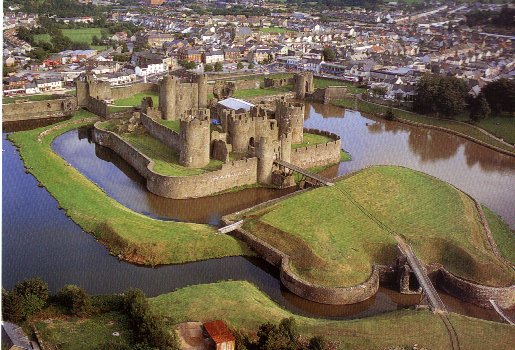 One night in Cardiff, and we
quickly moved on for a brief visit to Caerphilly (Caerffili)
Castle, Wales' largest castle with a duck-filled moat. Built,
destroyed, and rebuilt several times, its most picturesque part
was its leaning tower, caused by a Royalist explosion during the
Civil War.
One night in Cardiff, and we
quickly moved on for a brief visit to Caerphilly (Caerffili)
Castle, Wales' largest castle with a duck-filled moat. Built,
destroyed, and rebuilt several times, its most picturesque part
was its leaning tower, caused by a Royalist explosion during the
Civil War.
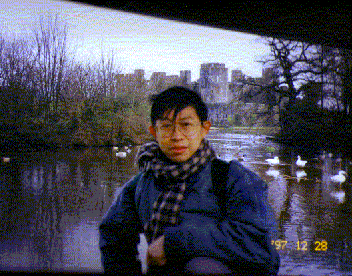 We have read about the
supposedly famous Caerphilly cheese but couldn't find it. The
locals told us that this famous cheese was now only available
from the tourist office, which was closed for the Christmas
holiday. Well, like many traditional products round the world,
this renowned cheese, too, had fallen under the onslaught of
uniform factory manufactured products.
We have read about the
supposedly famous Caerphilly cheese but couldn't find it. The
locals told us that this famous cheese was now only available
from the tourist office, which was closed for the Christmas
holiday. Well, like many traditional products round the world,
this renowned cheese, too, had fallen under the onslaught of
uniform factory manufactured products.
"Ugly, lovely town."
Swansea, as described by Dylan Thomas
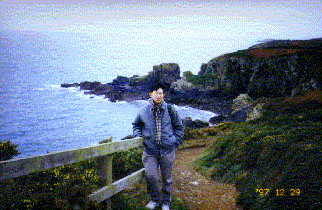 We then sped towards Swansea
(Abertawe - the Welsh name - note the great difference in English
and Welsh names), and birthplace of renowned Welsh writer, Dylan
Thomas. Founded by Sweyne the Viking, the city is Wales' second
largest. My favourite guidebook on Wales ("Wales" by
Peter Sager, from where I would quote from time to time in this
write-up) says that Swansea has the most beautiful setting and
the most exotic food - the people here eat seaweed. They call it
laver bread - it's protein-rich, and made from seaweed collected
from the coast of Gower, cooked in oatmeal, eaten with bacon or
ham. Didn't have much time to spare. So we had a brief stop at
Swansea Bay/Gower Peninsula before entering Carmarthenshire
(legendary birthplace of Merlin, the magician) on our way to St
David's on the Pembrokeshire coast. On a cliffside around here,
schoolboy Dylan Thomas once cried, "Why don't we live
here always? Always and always. Build a bloody house and live
like bloody kings," before adding laconically, "It's
too wild for a townee." ["Wales' by Peter Sager]
We then sped towards Swansea
(Abertawe - the Welsh name - note the great difference in English
and Welsh names), and birthplace of renowned Welsh writer, Dylan
Thomas. Founded by Sweyne the Viking, the city is Wales' second
largest. My favourite guidebook on Wales ("Wales" by
Peter Sager, from where I would quote from time to time in this
write-up) says that Swansea has the most beautiful setting and
the most exotic food - the people here eat seaweed. They call it
laver bread - it's protein-rich, and made from seaweed collected
from the coast of Gower, cooked in oatmeal, eaten with bacon or
ham. Didn't have much time to spare. So we had a brief stop at
Swansea Bay/Gower Peninsula before entering Carmarthenshire
(legendary birthplace of Merlin, the magician) on our way to St
David's on the Pembrokeshire coast. On a cliffside around here,
schoolboy Dylan Thomas once cried, "Why don't we live
here always? Always and always. Build a bloody house and live
like bloody kings," before adding laconically, "It's
too wild for a townee." ["Wales' by Peter Sager]
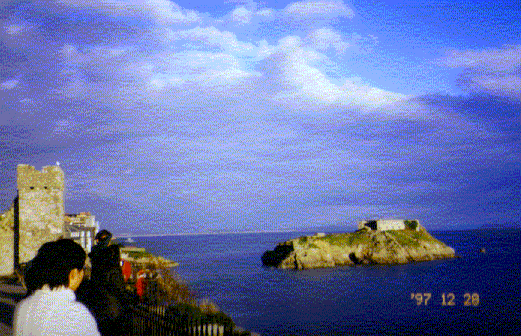 The Pembrokeshire Coast
National Park is a beautiful area of rugged cliffs, cute little
farming and fishing villages, sandy beaches and rocky coves. On
the way to St David's, we passed Tenby, Pembroke, Manorbier, and
crossed the Milford Haven, a wide inlet from the Atlantic.
The Pembrokeshire Coast
National Park is a beautiful area of rugged cliffs, cute little
farming and fishing villages, sandy beaches and rocky coves. On
the way to St David's, we passed Tenby, Pembroke, Manorbier, and
crossed the Milford Haven, a wide inlet from the Atlantic.
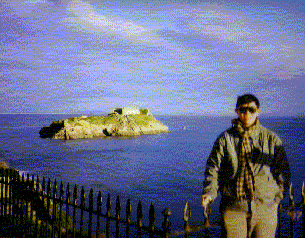 Tenby, is known in Welsh as
Dinbych-y-pysgod, Little Fort of Fishes. This is a beautiful
resort town, with some famous beaches and a fantastic cliffside
view. Here, we caught a glimpse of Caldey Island, home of a
community of Cistercian monks, seals and seabirds. The monks here
produce perfume, dairy products and chocolate. Women are
forbidden from setting foot on this island. I wonder how the
monks get their products tested, maybe on the mainland...
Tenby, is known in Welsh as
Dinbych-y-pysgod, Little Fort of Fishes. This is a beautiful
resort town, with some famous beaches and a fantastic cliffside
view. Here, we caught a glimpse of Caldey Island, home of a
community of Cistercian monks, seals and seabirds. The monks here
produce perfume, dairy products and chocolate. Women are
forbidden from setting foot on this island. I wonder how the
monks get their products tested, maybe on the mainland...
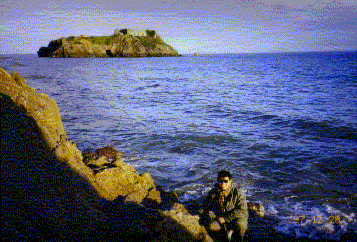 Manorbier was the birthplace
of Giraldus Cambrensis, 12th century cleric, warrior, traveller,
writer and a staunch Welsh nationalist. Born of a Norman baron
father and a Welsh princess, Gerald the Welshman (Geralt Gymro),
as he is also known, was particularly famous as a meticulous
observer of mediaeval Welsh life. He once said, "The
Welsh goes to extreme in all matters. You may never find anyone
worse than a bad Welshman, but you will certainly never find
anyone better than a good one." ['Wales" by Peter
Sager].
Manorbier was the birthplace
of Giraldus Cambrensis, 12th century cleric, warrior, traveller,
writer and a staunch Welsh nationalist. Born of a Norman baron
father and a Welsh princess, Gerald the Welshman (Geralt Gymro),
as he is also known, was particularly famous as a meticulous
observer of mediaeval Welsh life. He once said, "The
Welsh goes to extreme in all matters. You may never find anyone
worse than a bad Welshman, but you will certainly never find
anyone better than a good one." ['Wales" by Peter
Sager].
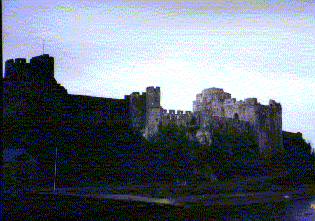 Pembroke is famous for its
castle, where Henry Tudor was born. His father, Edmund Tudor, was
the son of Queen Catherine of Valois and Owain Tudor, the Welsh
knight she secretly married after the death of King Henry V ( -
it was a scandalous event of the times). Edmund married the
Countess of Richmond, a claimant to the throne, and got involved
in the messy Wars of the Roses. He was killed as a result but his
son, Henry, founded the Tudor Dynasty by invading England with
his Welsh archers. Of course, the Welsh were fond of reminding
visitors that they once, had conquered England. Proud of his
Welsh descent as to add the red dragon (the national symbol of
Wales) to his arms, Henry VII did little to uplift the status of
his land of birth. Welsh dreams of freedom were once again swept
under the carpet.
Pembroke is famous for its
castle, where Henry Tudor was born. His father, Edmund Tudor, was
the son of Queen Catherine of Valois and Owain Tudor, the Welsh
knight she secretly married after the death of King Henry V ( -
it was a scandalous event of the times). Edmund married the
Countess of Richmond, a claimant to the throne, and got involved
in the messy Wars of the Roses. He was killed as a result but his
son, Henry, founded the Tudor Dynasty by invading England with
his Welsh archers. Of course, the Welsh were fond of reminding
visitors that they once, had conquered England. Proud of his
Welsh descent as to add the red dragon (the national symbol of
Wales) to his arms, Henry VII did little to uplift the status of
his land of birth. Welsh dreams of freedom were once again swept
under the carpet.
![]() St
David's - Saints & Pilgrims.....Mid-Wales:
Heroes & Crosses.....Snowdonia
(Eryri) & Gwynedd - the Real Wales.....Stones,
Statesmen, 10,000 Saints & a Mysterious Isle.....Of
Spirits & Castles
St
David's - Saints & Pilgrims.....Mid-Wales:
Heroes & Crosses.....Snowdonia
(Eryri) & Gwynedd - the Real Wales.....Stones,
Statesmen, 10,000 Saints & a Mysterious Isle.....Of
Spirits & Castles
